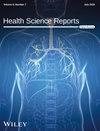Malaria in Pregnancy and Predisposing Factors in Jor District of Gambella Region, Southwest Ethiopia: A Cross-Sectional Study
Abstract
Background and Aims
Malaria in pregnancy remains a major public health concern in Ethiopia, particularly in high-endemic regions like Gambella. Despite the high burden, no peer-reviewed published study exists on its prevalence and associated risk factors among pregnant women in Jor District, Gambella region. This study aimed to determine the prevalence of malaria in pregnancy and its associated factors in Jor District, Gambella, Ethiopia.
Methods
A facility-based cross-sectional study was conducted from February 29 to April 10, 2024, among 446 pregnant women selected using systematic random sampling. Data were gathered through microscopy-based blood film examination and face-to-face interviews using a structured questionnaire. Descriptive statistics were performed to obtain frequencies and percentages, whereas logistic regression analyses were performed to identify independent risk factors for malaria, with statistical significance set at p < 0.05. All analyses were performed with SPSS version 24 (IBM, USA).
Results
The prevalence of malaria was found to be 15.2% (95% CI: 11.4, 17.5). Plasmodium falciparum 8.96% (40/446) and Plasmodium vivax 2.7% (12/446) and 3.6% (16/446) for comorbidity (P. falciparum and P. vivax) are the two species identified in this study. The factors associated with malaria were no formal education (AOR = 1.32), lack of knowledge about malaria transmission (AOR = 2.7), presence of stagnant water near residence area (AOR = 3.61), non-ownership of ITN (AOR = 5.74), and low altitude (AOR = 5.26). Due to smaller sample size in some of the categories of the independent variables such as non-ownership of ITN and altitude the confidence intervals are wider.
Conclusions
The prevalence of malaria was high in the study area. Non-ownership of ITNs, lack of formal education, lack of knowledge about malaria transmission, and residing at lower altitudes and presence of stagnant water near residence of pregnant women were significantly associated with malaria among pregnant women. Public health actions such as improving access of pregnant women's to formal education over the long term, increasing pregnant women' access to ITN along with health education on proper utilization of ITN, health information dissemination about transmission of malaria and environmental modification such as removal of stagnated water for the control of mosquito vectors were recommended.


 求助内容:
求助内容: 应助结果提醒方式:
应助结果提醒方式:


